(Note: you can click on the small photos to enlarge them. Use your back button to return to the blog.)
On Saturday, August 18, 2018, we untied the dock lines and headed north on Cat’s Cradle. Our goal: Catch up with Scott and Cora, now 12, and ‘assist’ in their competition in the Barefoot Raid – 2018. ( www.barefootraid.net ) We sailed and motor-sailed against the light northerly winds-first to Montague Harbor on Galiano Island, and then toward French Creek (north of Nanaimo) to meet Scott and Cora. At Montague on Sunday morning we carefully plotted our northward plan, remembering the dreaded Dodd Narrows looming about 20 miles ahead of us.
Dodd Narrows is a 50 meter wide opening between the Gulf Islands of British Columbia and the open waters of the Strait of Georgia. We say ‘dreaded’ because we have had two past challenges here. Years ago, leaving Nanaimo early in the morning to catch the slack current at Dodd Narrows, we saw in the darkness of early dawn the red lights of a vessel ahead of us. No, that is a green light. Oops, it’s both red and green. Now it’s white. What is going on? We soon found out when we hit a big log that had escaped from a little tug that had been dashing around in front of us. The log cracked the extension that holds our propeller down in the water. BANG! This was not good. We limped home under duck tape and ropes holding things together and spent several months flying repair parts in from England.
Then, just a couple of years ago, we came down from the north in the Strait of Georgia under spinnaker – hour after hour – mile after mile. Val was enjoying this and decided to carry on through Dodd Narrows under spinnaker. Leslie was ‘driving’ and Val was fiddling with the big green sail. All was going so well – until – just as we were 100 meters from the narrowest part and other vessels were squeaking by in the opposite direction – the spinnaker collapsed which completely blocked Leslie’s view. She had the motor runinng but could not see what was happening. Val pulled and gathered and just before all hell would have broken loose, Leslie was able to see again and with various twists of the wheel, we made it through the narrows. A lesson here – “No Spinnakers in the Narrows”.
So, here we go again. Motoring northward (winds are weak), we adjust our speed so that we will hit the narrows at slack – when the current is zero. Seemed like a very prudent plan….. No spinnakers and no driving in the dark. All is going well – actually, too well. A mile (15 minutes) before the narrows, a big tug comes charging up from behind us going very fast and throwing a huge wake. We grimace as our motoring sailboat bounces around. Why would that big vessel be in such a hurry in these tight quarters? Now, we are 2 minutes from the narrows and our timing is perfect. We will go through exactly at slack! Then, coming into view just as we are about to enter the narrows, we see a big tug pulling a huge boom of logs and seconds later, we see the big tug that had just passed us is pushing this way and that way at the other end of the fleet of logs. Men were jumping off that tug and running around on the bouncing logs. We put the wheel hard over and did about 10 very tight circles about a hundred meters away as the two tugs slowly got their tow through the narrows. Another lesson here – “Don’t try for slack, go an hour or so before or after slack when the current will help your passage and the log booms will have finished their maneuvering”.

By 5 pm, we were anchored off French Creek and there were Scott and Cora working on putting their home-built Polynesian designed 21 foot catamaran together. Here Scott is making ‘final’ adjustments while Cora is filling water-balloons with a PVC pipe pump she made. Watch out sailors!! Around them were a myriad of other crews working on getting their little boats ready for the water. We helped a bit and all had dinner ‘near’ the local pub – we had to sit at an outside picnic table and only drink lemonade as we had a minor, and a lovely, sweet, enthusiastic one at that. At this establishment they are taking every precaution to protect said minors, it would seem.
In the morning, the captains met and soon all the boats were sailing or pedaling or paddling back and forth in the light winds and at 9 am they were off, headed across the Strait of Georgia and racing to lunch on Sangster Island and then on to dinner in Long Bay on Jedediah Island.
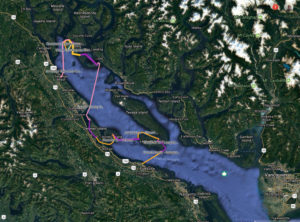 The notion of a “raid” is an old, English one. Quill, of Silva Bay, conceived of this current effort to recreate a boating activity that has fallen out of favor. This race would be competitive yet cooperative and above all, social. Each day of the week-long event has two races, one in the morning and one in the afternoon. All of the competitors meet on a huge landing craft for all meals – breakfast, lunch and dinner. The craft, named “Poor Man’s Rock”, is quite the boat with stuff piled everywhere yet room enough to cook and serve meals for the group of about 50 people who gathered on the lower deck of the landing craft or hung out above the cabin on the roof at mealtimes. At meals, up to 20 little boats would be rafted to the “Rock”. With all the smoke that we experience in the first few days, mealtimes on the barge looked a bit like scenes from a dystopic movie named Waterworld.
The notion of a “raid” is an old, English one. Quill, of Silva Bay, conceived of this current effort to recreate a boating activity that has fallen out of favor. This race would be competitive yet cooperative and above all, social. Each day of the week-long event has two races, one in the morning and one in the afternoon. All of the competitors meet on a huge landing craft for all meals – breakfast, lunch and dinner. The craft, named “Poor Man’s Rock”, is quite the boat with stuff piled everywhere yet room enough to cook and serve meals for the group of about 50 people who gathered on the lower deck of the landing craft or hung out above the cabin on the roof at mealtimes. At meals, up to 20 little boats would be rafted to the “Rock”. With all the smoke that we experience in the first few days, mealtimes on the barge looked a bit like scenes from a dystopic movie named Waterworld.
Quill and many of these racers, including Scott, were previously competitors in the 1000 km Race to Alaska from Victoria to Ketchican. And though they are properly proud of themselves for competing in such a challenging activity, they are looking forward to a racing scene where all can also become friends.
So, off we go – in the smoke of many BC fires – paddling or pedaling or sailing or combinations thereof. Leslie and Val, on Cat’s Cradle, were ‘supporting’ rather than racing, though they did do a lot of sailing. The picture here shows their path on the chart-plotter, tacking up a narrow channel before they ended the first day at Long Bay on Jedadiah Island. All these turns are a lot of work and at times it seems little progress was made but persistence paid off!
here shows their path on the chart-plotter, tacking up a narrow channel before they ended the first day at Long Bay on Jedadiah Island. All these turns are a lot of work and at times it seems little progress was made but persistence paid off!
 This region has been dominated by a strong high pressure system in the Northeast Pacific and the resulting northerly winds have brought smoke down from fires on the BC mainland. Fortunately the weather pattern shifted after several smoky days and the sky cleared but still light winds remained. On several occasions, we used Cat’s Cradle to tow 1, 2, or 3 little boats at a time for the final miles to the next goal after lack of wind and exhaustion crept in.
This region has been dominated by a strong high pressure system in the Northeast Pacific and the resulting northerly winds have brought smoke down from fires on the BC mainland. Fortunately the weather pattern shifted after several smoky days and the sky cleared but still light winds remained. On several occasions, we used Cat’s Cradle to tow 1, 2, or 3 little boats at a time for the final miles to the next goal after lack of wind and exhaustion crept in.
Scott spent much time tweaking his new mast (two long wooden poles, tied together at the top) and other racers worked to fix things as needed along the way.
It wasn’t all work, though.
One day during the Raid, we sailed near several humpback whales that were in the middle of the Strait of Georgia a few miles south of Mitlenatch Island. Humpback whales were ‘fished’ out of the Strait of Georgia in the 1920-1930 period. On the north end of nearby Texada island is an abandoned whaling station dating to those days. Over the past 10 years or so, humpback whales have been returning to the Salish Sea which is a hopeful sign, especially as contrasted with the plight of the struggling orcas. We found ourselves fortunate to be able to watch these huge animals and hear their explosive blows.
 At the end of the race, we pulled Scott’s boat and two others about 5 miles over to a boat ramp a bit south of Campbell River. Here these sailors caught a ride south, collected their cars and trailers, took their boats apart and headed back to their regular lives. Leslie and Val decided to go whichever way the wind wanted us to sail; this turned out to be toward the southeast, so we sailed downwind over to Mitlenatch Island.
At the end of the race, we pulled Scott’s boat and two others about 5 miles over to a boat ramp a bit south of Campbell River. Here these sailors caught a ride south, collected their cars and trailers, took their boats apart and headed back to their regular lives. Leslie and Val decided to go whichever way the wind wanted us to sail; this turned out to be toward the southeast, so we sailed downwind over to Mitlenatch Island.
Mitlenatch Island – For the Birds
Conditions were near perfect as we cautiously approached at low water an island we’d always wanted to explore but never could because of adverse winds, tides or cu rrents. We slowly entered small Camp Bay, carefully avoiding the rocky reef to starboard and hoped that this bay would give us protection from the predicted Northwesterlies. One of our cruising guides warns us that the bay is shallow, and the depth sounder confirms that: 10 feet. It also says “moderate holding over a bottom of mud, sand and shells. It is dead calm and the sea is tranquil, glassy and flat. It should be safe, we think, with our shallow 1 ½ foot draft and an almost-full moon tidal exchange of 6 feet….. We drop the hook and take the dinghy to the beach which is covered with thousands of sharp oysters.
rrents. We slowly entered small Camp Bay, carefully avoiding the rocky reef to starboard and hoped that this bay would give us protection from the predicted Northwesterlies. One of our cruising guides warns us that the bay is shallow, and the depth sounder confirms that: 10 feet. It also says “moderate holding over a bottom of mud, sand and shells. It is dead calm and the sea is tranquil, glassy and flat. It should be safe, we think, with our shallow 1 ½ foot draft and an almost-full moon tidal exchange of 6 feet….. We drop the hook and take the dinghy to the beach which is covered with thousands of sharp oysters.
Mitlenatch Island is a Provincial Nature Park and a protected seabird colony. It is also the largest (and probably noisiest!) colony in the Strait of Georgia. Part of an ancient volcanic plateau, First Nations people used it as a seasonal camp where they collected fish, sea urchins, shellfish, camus bulbs and eggs of seabirds. In 1894, a family from Cortez Island bought the island to graze cattle and sheep. The B.C. province bought it in 1959, and two years later it was designated a Provincial Nature Park. Today it has an international title of IBA, or Important Bird Area. IBA is a scientific effort to identify, conserve and monitor a network of similar sites which provide critical habitats for bird populations around the world.
 All marine life is protected on this island, and we were anxious to see some of the nesting Pelagic and Double-Crested Cormorants and numerous pairs of Glaucous-winged gulls. On shore, we talked with friendly volunteer stewards, learning that numbers of birds have significantly decreased over the past years. We walked the well-maintained trails and visited a primitive bird blind to quietly observe a few cormorants. We then return to Cat’s Cradle to circumnavigate the island in our dinghy to more closely observe the many seals we saw as we initially approached this rugged island. Although we watched from a distance and our small
All marine life is protected on this island, and we were anxious to see some of the nesting Pelagic and Double-Crested Cormorants and numerous pairs of Glaucous-winged gulls. On shore, we talked with friendly volunteer stewards, learning that numbers of birds have significantly decreased over the past years. We walked the well-maintained trails and visited a primitive bird blind to quietly observe a few cormorants. We then return to Cat’s Cradle to circumnavigate the island in our dinghy to more closely observe the many seals we saw as we initially approached this rugged island. Although we watched from a distance and our small 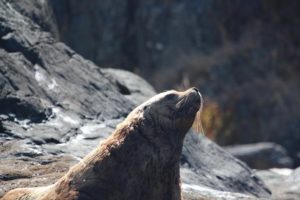 electric dinghy motor was quiet, the seals were quite wary, and several slid quickly down their smooth rocky perches near Northwest Bay. At one point we observed a huge sea lion which is basking lazily in the bright sun. Seals of many colors and sizes were taking a mid-afternoon snooze. We viewed a busy group of nesting cormorants while noisy gulls of all ages soared and screeched above us. A lone osprey flew overhead while an oystercatcher stood out along the barnacle-laden shoreline with its bright red beak and matching eyes.
electric dinghy motor was quiet, the seals were quite wary, and several slid quickly down their smooth rocky perches near Northwest Bay. At one point we observed a huge sea lion which is basking lazily in the bright sun. Seals of many colors and sizes were taking a mid-afternoon snooze. We viewed a busy group of nesting cormorants while noisy gulls of all ages soared and screeched above us. A lone osprey flew overhead while an oystercatcher stood out along the barnacle-laden shoreline with its bright red beak and matching eyes.
Back on Cat’s Cradle, the wind slowly and subtly shifted to the southeast as we prepared dinner.  As Val makes pasta and Leslie uses farm-stand veggies to make a salad, we hear a strange sound and ask each other, “What was that?” We look through the salon window, and a huge basalt boulder is staring at us through the port window! (Leslie swears she saw menacing eyes and an evil grin on the boulder….) Cat’s Cradle’s anchor had dragged when the wind had shifted! We leaped into action by quickly starting the engine and slowly going in reverse – away from the monster rock. We then found another spot in the bay and dropped the anchor again with a longer scope ratio of 5:1 so that we could hopefully sleep soundly at anchor that night, and we did.
As Val makes pasta and Leslie uses farm-stand veggies to make a salad, we hear a strange sound and ask each other, “What was that?” We look through the salon window, and a huge basalt boulder is staring at us through the port window! (Leslie swears she saw menacing eyes and an evil grin on the boulder….) Cat’s Cradle’s anchor had dragged when the wind had shifted! We leaped into action by quickly starting the engine and slowly going in reverse – away from the monster rock. We then found another spot in the bay and dropped the anchor again with a longer scope ratio of 5:1 so that we could hopefully sleep soundly at anchor that night, and we did.
The next morning we decided we would go whichever way the wind wanted us to go, and this turned out to be a light northwest wind blowing us back to Savary Island where we had stopped earlier with the Raid. Then, the following day we continued on with a 25 mile spinnaker run to the southeast, stopping again at funky Lasqueti (below), and for two nights on Jedadiah Island.
On Jedadi ah, an idyllic and protected island, we walked various trails and even stumbled onto the grave of “Will”, a horse left by earlier settlers who roamed the island for years and years. Home Bay, with its little old home in the background, is one of our favorite spots in all of the Northwest!
ah, an idyllic and protected island, we walked various trails and even stumbled onto the grave of “Will”, a horse left by earlier settlers who roamed the island for years and years. Home Bay, with its little old home in the background, is one of our favorite spots in all of the Northwest!
The northwest wind continued and so on we went – now back down and across the Strait of Georgia to visit Clam Bay (Thetis and Kuper Islands) and with one more long spinnaker day we were back in US waters. At that moment, J pod appeared and paralleled us for more than an hour as we slowly cruised along at a distance. After a couple more nights at anchor in Reid Harbor on Stuart Island (with a fun rendezvous dinner with the Johnsons and Leffs), we putt-putted back home to our slip in Mitchell Bay. Almost three fine weeks – out and about along the BC coast!





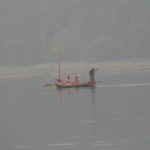

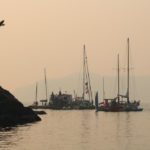


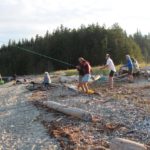

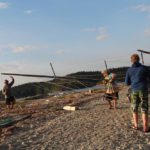



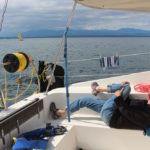




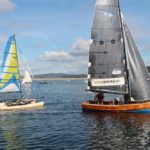





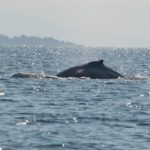
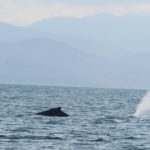



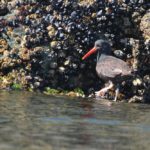

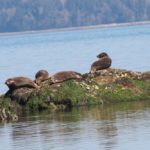

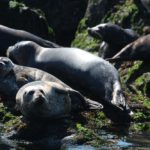
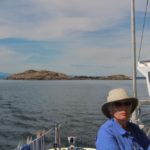
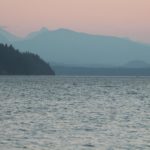





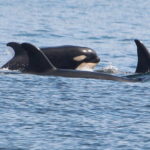

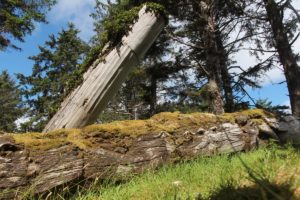

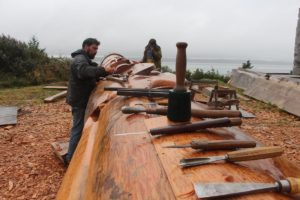
Quill
6 Sep 2018What a wonderful account, and a great bunch of was great having you guys along, and I really appreciate all your help shepherding our little fleet around.
Thank you.
All the best,
Quill
Robin
6 Sep 2018Here I am sitting on a rock at Mt. Rushmore reading your wonderful account and enjoying the magnificent photos. Kudos to you both for another fun and being in the moment journey.
Bill Rosser
6 Sep 2018What a wonderful adventure for all of you! Great story and photos!
Carol
6 Sep 2018How great to have a “goofy” event like the race get you away from the routines of home and just following the ways of the wind. It sounds very romantic with the spice of errant log boom and evil rocks to flavor your memories.
May you keep adventuring.
Carol
Jennifer Johnson
6 Sep 2018Hi Leslie & Val-
As I take a break from grading papers and planning lessons, I get to escape to the wonders of water and nature. Thanks for the break from my usual scenery!
xox Jen
Julia
6 Sep 2018It looked like perfect weather (except the early days of smoky skies). Lovely to see you on the move again and VERY happy to see J pod after all its sad news this summer. Hugs,
Julia
Heidi
6 Sep 2018Nice to meet you both on the Raid. Love The polyinesion homebuild sail craft.
Sorry to miss Cora but glad we escaped the famed balloons.
Enjoyed your story and hope we meet again on the Raid paths next year.
Heidi & Tor
Lindsay
7 Sep 2018Great account of what looks and sounds like a very fun trip! Scott and Cora are so adventurous, as usual! I’m glad the narrows were better this time around. Love the pictures of humpbacks, seals and J pod especially.
Stormy Burns
8 Sep 2018What a wonderful trip – especially for Cora. Three generations of sailors!
Barbara
9 Sep 2018Quite a trip, how right to go where the wind blows….